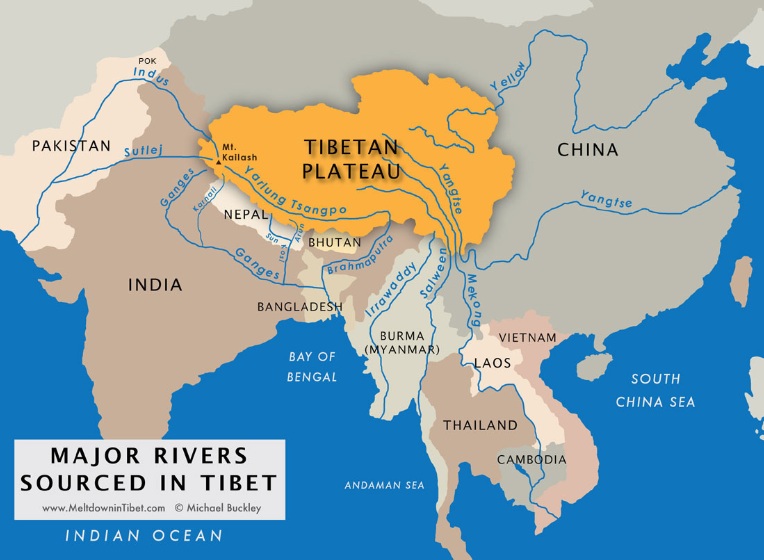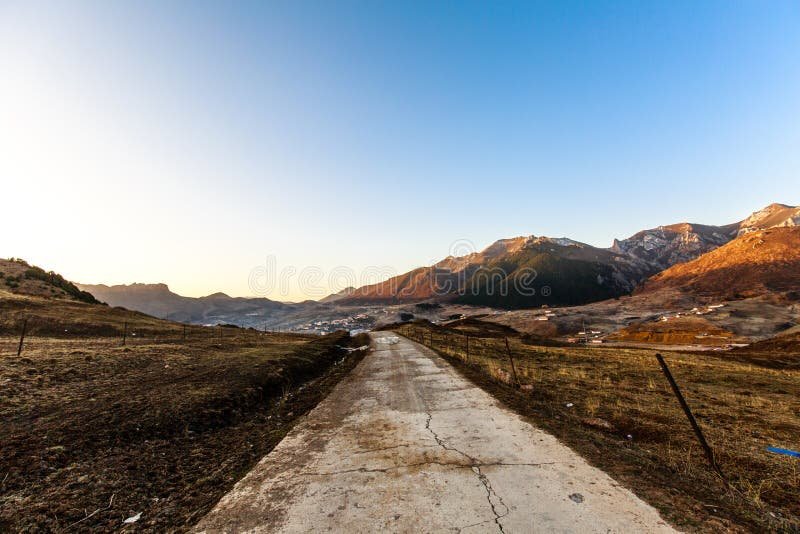Gateway To The Highlands: Entering Tibet From Nepal

Tibet, a land of mystery and allure, has long captured the imagination of travelers and adventurers worldwide. Nestled amidst the towering peaks of the Himalayas, this sacred land holds a rich tapestry of ancient culture, breathtaking landscapes, and profound spiritual traditions. While Tibet remains largely closed to foreign visitors, there is one route that offers a glimpse into this enigmatic realm: the overland journey from Nepal.

The Journey Begins: Kathmandu to the Border

The gateway to Tibet from Nepal is the bustling capital city of Kathmandu, a vibrant hub of culture, history, and spirituality. From here, travelers embark on a scenic drive that winds through picturesque hill towns, terraced rice fields, and lush valleys, Gradually, the landscape transforms, revealing rugged mountain peaks and the first glimpse of the Tibetan Plateau ahead.
Kodari: The Final Outpost
The journey culminates at the border town of Kodari, perched on the banks of the Bhotekoshi River. This small settlement is imbued, with an air of excitement and anticipation, as it serves as the last stop before entering Tibet. Kodari bustles with activity as travelers prepare for the crossing, exchanging currencies, and seeking travel permits. The Tibetan border is just a stone’s throw away, marking the threshold to a world apart.
Crossing the Friendship Bridge: A Moment of Significance
The Friendship Bridge, spanning the Bhotekoshi River, connects Nepal and Tibet. This bridge holds immense symbolic and historical significance, representing the enduring friendship between these two neighboring countries. As travelers cross the bridge, they are greeted by Tibetan immigration officials, who stamp their passports, marking their official entry into Tibet.
Gyirong: The First Tibetan Town
Just beyond the border lies the town of Gyirong, the first Tibetan town on the journey. Gyirong exudes an atmosphere of Tibetan culture, with its traditional architecture, colorful prayer flags fluttering in the breeze, and the melodious, chant of monks reverberating through the air. Here, travelers can experience authentic Tibetan hospitality, savor local cuisine, and immerse themselves in the unique charm of this remote Himalayan town.
Venturing Further into the Tibetan Highlands
From Gyirong, the journey continues deeper into the Tibetan Highlands. The landscape becomes increasingly rugged and awe-inspiring, with towering peaks, glacial valleys, and expansive plateaus, stretching as far as the eye can see. Along the way, travelers may encounter nomadic herders tending their yaks, glimpse ancient monasteries perched on mountain slopes, and witness the vibrant Tibetan culture unfold before them.
Lhasa: The Heart of Tibet
The ultimate destination of this overland journey is Lhasa, the spiritual and cultural heart of Tibet. This ancient city boasts a treasure trove of architectural wonders, including the towering Potala Palace, the Jokhang Temple, and the iconic Barkhor Street. Lhasa pulsates with the energy of devout pilgrims, monks clad in maroon robes, and a harmonious blend of Tibetan and Chinese cultures.
A Journey of Discovery and Transformation
The overland journey from Nepal to Tibet is more than just a physical crossing of borders. It is an immersive experience that transports travelers to a realm of cultural, spiritual, and natural wonders. It is a journey that challenges preconceptions, expands horizons, and invites deep reflection on the essence of life and the interconnectedness of humanity. For those who embark on this extraordinary adventure, the rewards are immeasurable, leaving an enduring legacy of memories and a profound appreciation for the beauty and diversity of the world.# Gateway To The Highlands: Entering Tibet From Nepal
Executive Summary
Tibet, a land of mystery and beauty, has been alluring travelers and adventurers for centuries. While there are several ways to enter Tibet, one of the most popular and rewarding is through Nepal. This route offers breathtaking scenery, rich cultural experiences, and the chance to visit some of Tibet’s most sacred sites.
Introduction
Nestled in the heart of the Himalayas, Tibet is often referred to as “the roof of the world.” With its独特的spiritual and cultural heritage, Tibet beckons travelers from far and wide. While there are multiple routes to reach this enigmatic destination, the Nepal-Tibet border crossing remains a top choice due to its stunning vistas, cultural exchanges, and access to spiritual monuments. Embark on this extraordinary journey and discover the allure of Tibet through Nepal.
The Journey Begins: Preparing for Tibet Entry
Entering Tibet from Nepal requires careful planning and preparation. Here are a few crucial aspects to consider:
- Tibet Travel Permit: Securing a Tibet Travel Permit (TTP) is essential. Coordinate with a reputable tour operator to handle the application process, which involves submitting a comprehensive set of documents and adhering to specific regulations.
- Choosing the Right Tour Operator: Select an experienced and reliable tour operator familiar with Tibet’s unique requirements and challenges. They will assist in obtaining the TTP, arrange transportation, provide necessary supplies, and ensure a safe and enjoyable experience.
- Packing for Altitude: As Tibet lies at high elevations, travelers must pack accordingly. Warm clothing, sunscreen, sunglasses, and other items suitable for cold and high-altitude conditions are crucial.
- Health Considerations: Acclimatization to high altitudes is essential to avoid altitude sickness. Consult a doctor for advice on medications, gradual ascent, and other preventive measures.
- Respecting Tibet’s Culture and Traditions: Tibet is a deeply spiritual region with a rich cultural heritage. As a visitor, it is important to show respect for local customs, traditions, and religious practices.
Exploring Tibet’s Cultural Treasures
Tibet is home to a wealth of cultural and historical treasures that reflect its unique identity. Here are some key aspects to delve into:
- The Potala Palace: As the former residence of the Dalai Lama, the Potala Palace stands as one of Tibet’s most iconic landmarks. This architectural marvel offers a glimpse into the region’s rich history and spiritual legacy.
- Jokhang Temple: Considered one of the most sacred sites in Tibetan Buddhism, the Jokhang Temple is renowned for its exquisite architecture and spiritual significance. Its holy atmosphere draws pilgrims from near and far.
- Norbulingka Palace: Once the summer residence of the Dalai Lama, Norbulingka Palace is a sprawling estate with sprawling gardens, temples, and traditional Tibetan architecture. It provides insights into the lifestyle of Tibet’s spiritual leaders.
- Barkhor Street: A lively and colorful hub in Lhasa, Barkhor Street is lined with traditional Tibetan shops, restaurants, and temples. It offers a vibrant glimpse into the local culture and serves as a prime destination for souvenirs.
- Tibetan Arts and Crafts: Tibet is renowned for its exquisite arts and crafts, including vibrant carpets, intricate thangkas (religious paintings), and meticulously crafted jewelry. These creations showcase the region’s artistic prowess and cultural identity.
Natural Wonders of Tibet
Tibet’s natural beauty is awe-inspiring and diverse. From majestic mountains to pristine lakes, here are some natural wonders not to miss:
- The Himalayas: The awe-inspiring Himalayas, including Mount Everest, form the backdrop of Tibet’s landscapes. Their rugged peaks and glaciers offer breathtaking panoramas, creating an unforgettable experience for trekkers and nature enthusiasts.
- Yamdrok Lake: Known as “the turquoise lake,” Yamdrok Lake is a stunning natural wonder located south of Lhasa. Its crystal-clear waters and picturesque surroundings make it a popular destination for relaxation and rejuvenation.
- Namtso Lake: Situated in northern Tibet, Namtso Lake is the highest saltwater lake in the world. Its vast expanse and beautiful blue waters attract visitors seeking tranquility and breathtaking vistas.
- Mount Kailash: Considered a sacred mountain in four religions, Mount Kailash is a pilgrimage site for devout Hindus, Buddhists, Jains, and Bon practitioners. Its imposing presence and spiritual significance draw pilgrims from around the globe.
- Ganden Monastery: Located about 40 kilometers from Lhasa, Ganden Monastery is one of the “Great Three” Gelugpa monasteries in Tibet. With its impressive architecture and rich history, it captivates visitors with its spiritual ambiance and stunning views.
High-Altitude Challenges and Precautionary Measures
Tibet’s high altitude can pose challenges to travelers. Here are some important precautions to take:
- Acclimatization: Gradual ascent and adequate time for acclimatization are crucial to prevent altitude sickness. Proper hydration, healthy nutrition, and sufficient rest are essential during this process.
- Medical Precautions: Carry necessary medications, including altitude sickness remedies, and consult a doctor beforehand for personalized advice. Monitor your physical condition throughout your journey and seek assistance if symptoms of altitude sickness arise.
- Physical Activity: Engage in physical activities gradually to give your body time to adjust to the high altitude. Overexertion can exacerbate altitude sickness symptoms.
- Proper Clothing and Gear: Ensure your clothing and gear are suitable for cold weather and high altitudes. This includes warm layers, proper footwear, and essential equipment like trekking poles and sunglasses.
- Listen To Your Body: Be mindful of your physical and emotional well-being. Take regular breaks, stay hydrated, and avoid pushing yourself too hard. If you feel unwell, seek medical attention promptly.
Conclusion
Exploring Tibet through Nepal is a journey of cultural discovery, natural wonders, and personal growth. With careful preparation, acclimatization, and respect for the region’s unique heritage, travelers can immerse themselves in the Tibetan experience and create memories that will last a lifetime.
Keyword Phrase Tags:
- Nepal Tibet border crossing
- Tibet Travel Permit
- Exploring Tibet’s cultural treasures
- Natural wonders of Tibet
- High-altitude challenges in Tibet
